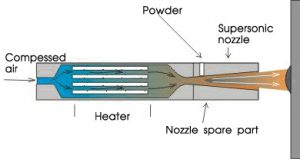The Dynamic Metal Fusion DYMET® technology for metal coating deposition is a version of method Cold gas-dynamic Spray (Cold Spray) http://en.wikipedia.org/wiki/Gas_dynamic_cold_spray
The Cold Spray is based on the discovery (made in 1980s) that particles moving at supersonic speed adhere to a surface after collision. The DYMET® has received the name «Low Pressure Cold Spray» (LPSC).
Unique innovations of DYMET® are:
– use of low-temperature compressed air as the working gas medium.
– use of a mixture of metal and ceramic particles in deposition, as a rule.
– introduction of powder material into the supersonic nozzle after its critical section.
The technology allows deposition of coatings onto metal, ceramic, glass, stone, and concrete substrates. Currently, DYMET® coatings can consist of aluminum, zinc, copper, tin, lead, babbit alloy, nickel, and other metals.
Key technology elements
In the DYMET® coating process, compressed air is heated and forced through a supersonic nozzle. Powder is fed into the resulting supersonic air jet, which accelerates the powder particles and deposits them onto the target substrate.
The powders are comprised of metals, alloys or mixtures of metal and ceramic particles. The treated surface can be either eroded or coated with necessary metal compositions depending on the operating mode of the device.
Unique aspects of the technology
Most traditional thermal spray coating methods imply deposition of material particles at high temperatures, usually above the melting point of the material being deposited.

In gas-dynamic spray technology (which can be practically referred to as ‘metal “growing”) this condition is not necessary. Deposition takes place by means of solid particles impacting the substrate at very high velocities. In the DYMET® series of devices, the acceleration of particles to necessary velocities is accomplished via a supersonic air jet. This equipment has no analogues in traditional coating methods.
Coatings created with DYMET® technology are free of the majority of disadvantages common to other metal deposition methods. They also possess a number of additional technological, economic, and ecological advantages. This makes the technology attractive to manufacturing enterprises and allows its effective application in a wide range of metal deposition tasks.
Advantages of LPCS
- the process does not require high pressures or temperatures and can be done in an air atmosphere;
- the temperature of the substrate does not rise above 100-150 С, which prevents the appearance of internal stresses and deformations, as well as oxidation of the substrate or deposition materials. This property of LPCS is extremely useful in the treatment of light alloy thin-walled parts, structurally complex objects, objects sensitive to deformation, and glass, ceramic, and other substrates;
- the technology is environmentally friendly (no high temperatures, dangerous gases or radiation, no chemically aggressive wastes);
- the technology uses a cheap and safe working gas: compressed air at 6-10atm;
- substrates do not require pre-heating;
- no mechanical preparation of the substrate is required: the high-velocity particle jet automatically cleans the target area of contaminants, rust, oils, and paint, and exposes the crystal structure of the substrate material;
- the particle jet is very controllable: it is narrow and has small cross-section. This makes possible to deposit coatings on specific areas or at specific points on a substrate, and to use stencils. (traditional thermal spray coating methods do not provide this opportunity);
- it is possible to deposit multi-component coatings with varying layer thickness;
- equipment is compact, portable, practically available for any industrial enterprise, and does not require extensive training or highly qualified personnel;
- equipment allows easy switching between abrasive spray treatment and material deposition;
- one device is used to deposit all coating types;
- equipment can be used in field conditions.
The high versatility and excellent quality of DYMET® coatings have been confirmed many times by both laboratory tests and industrial applications. Some metal deposition tasks were practically impossible to accomplish until the arrival of DYMET® technology.



